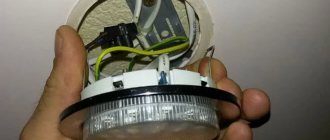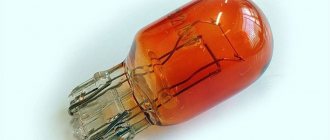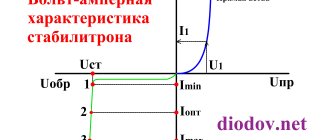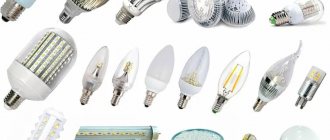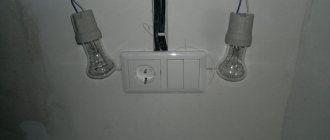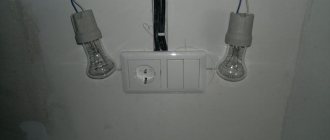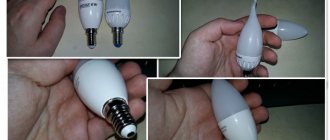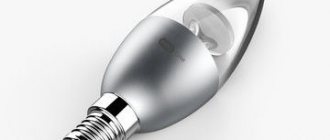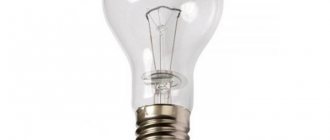Table of contents
Screw sockets Design and principle of operation of an electric screw socket Ceramic sockets Plastic sockets Carbolite sockets Sockets for pin sockets G Sockets for fluorescent lamps Sockets G5 Sockets G13 Double sockets 2 G13 Sockets for halogen lamps
Once upon a time, someone very smart said : “Yes, there will be light!” And there was light. And since then we have been nowhere without light. Especially in Russia, where in December the day lasts only a few hours. But thank God, we live in the twenty-first century and we have at our disposal a lot of devices that give us, although artificial, such necessary and pleasant light. Which is the simplest of these devices? Yes, of course, a light bulb! Where does a light bulb usually go? A light bulb, as everyone knows, is inserted into a socket. It’s these same cartridges that we’ll talk about now.
An electric cartridge is essentially a transmission link that transfers the energy of an electric current to a device that generates light. In addition, the cartridge also has a mounting function - it is in it that the device itself for generating light is mounted. Let us add that it can also have an aesthetic purpose, be beautiful, decorative and delight our eyes.
Figure 1. Electric sockets
Screw cartridges
The most common type of socket is screw socket, for lamps with base type E, where the letter E reminds us of the inventor of the incandescent lamp, the brilliant American self-taught Thomas Alva Edison. Edison screw type, that is, Edison screw. Lamps in this type of sockets can be screwed in and out. After the letter E, the diameter of the lamp base in mm is indicated. For example, the following cartridges exist: E5, E10, E14, E27 and E40. The most common cartridges in everyday life are E14 and E27. E40 sockets are mainly designed for powerful light sources and are used in street lighting.
Each cartridge is marked with information about its characteristics, which is applied to its body. Cartridges for E14 sockets have an operating current of no more than 2 A, a rated power of 440 W, E27 - no more than 4 A, 880 W; E40 - no more than 16 A, 3500 W. The marking applied to the cartridge body depends on the manufacturer and usually looks like this: 4A 250V, 4-250, 4/250. The maximum voltage supplied to the cartridge is 250 V.
Cartridge difference
Manufacturers use different types and sizes of chandelier sockets, both in one quantity and a small number of pieces in one chandelier, which differ in high overall dimensions. Often, ordinary E 27 or E 14 products are used for chandeliers; it is easier for them to select a lighting lamp.
But there are other types of products that are used in chandeliers. For example, the G series refers to halogen and fluorescent lamps with proper sockets.
The most common G types are G-4; G 9; G-R7S; GU10, so you need to carefully consider their choice. When you buy a chandelier, read its technical specifications so that you know which lamp you should use for this chandelier.
Important! For chandeliers with low voltage cartridges (G4), you need to choose a location for a step-down transformer.
It has a socket into which a light bulb or any chandelier is screwed. Sometimes it happens that it is necessary to replace not only the lamp, but also the lamp socket itself or repair it. Often the reason is that the cartridge body bursts or the contacts burn out.
Anyone can cope with this task on their own if they perform all the actions of a specific scheme. Be sure to follow electrical safety rules while working to avoid accidents.
Design and principle of operation of an electric screw chuck
The design of this cartridge is quite simple: it consists of three elements - a cylindrical body, where the sleeve with Edison thread is located, a ceramic liner and two copper or brass contacts for supplying electric current to the lamp. The connection of wires to the cartridge itself can be carried out in three ways: a screw connection to a ceramic insert with brass contacts mounted on it, using terminal blocks and a screwless method (for plastic cartridges).
Important! When connecting wires to the socket, the phase must be connected to the central contact of the light bulb base. With this connection, when screwing in and unscrewing the light bulb, the likelihood of electric shock is minimal.
Figure 2. Diagram of a threaded cartridge
Lamp socket with E14 , the second most common lamp socket after E27. It is especially often used for miniature incandescent lamps, which are popularly called minions. Lamps for this socket come in various shapes - spherical, candle-shaped, drop-shaped, pear-shaped. Depending on the type of surface, they can be transparent, mirror, or matte. The power of lamps for such sockets is usually limited to 60 Watts.
E27 screw chuck is the most common of all screw chucks. It should be noted that in addition to incandescent lamps, this socket can also be used with other types of lamps, such as LED, halogen, compact fluorescent, gas discharge and others. Such omnivorous nature of this cartridge allows you to painlessly switch, for example, from an incandescent lamp to an economical and durable LED lamp, just by unscrewing one lamp and screwing in another.
Screw sockets for E14 and E27 sockets, depending on the material from which they are made, come in three types: ceramic, plastic and carbolite.
Figure 3. Types of threaded cartridges
Threaded bases
We are all familiar with lamps with this base. They are used for lighting residential premises, as well as outdoors. Believed to have been developed by Thomas Edison and patented in 1894 specifically for incandescent lamps. That’s why it’s called “Edison Base”. The design is a cylinder with a thread with a diameter of 27 millimeters. The housing is made of aluminum, at the end of the housing there is a contact to which the electrodes are connected. The electrodes lead to a tungsten filament, which begins to glow when electric current passes through it. All incandescent lamps work on this principle. For LED lamps, the driver is located in the base. The dimensions of the base are standard, which makes the bulbs easily replaceable: diameter 27 millimeters, height 26.67 millimeters. In addition to incandescent lamps, energy-saving lamps, halogen, and LED are produced with this base.
It happens that you bought a lamp, but the bases in it are not suitable for your light bulbs. Don't despair, you can buy an adapter. Numerous adapters allow you to combine different sizes and even types of bases.
Light bulbs with a narrow base are also called minions. The design is the same as all lamps with screw bases. It is used for lighting apartments, houses, for local and general lighting, and is also often used in refrigerators. And in the same way, with such a base you can see an incandescent lamp, a halogen lamp, an energy-saving lamp, and an LED lamp.
The dimensions of the lamps in these sockets are appropriate; it is not for nothing that they are also called Goliath. The height of the base is different and is 47.75 millimeters. Such lamps are not used in everyday life; they are used mainly for street lighting or for large objects.
Ceramic cartridge
It is made of heat-resistant ceramics, so it can withstand high heating temperatures. It consists, most often, of a single body that cannot be disassembled into parts, with a threaded sleeve built into it. Connection to electric current is made through screw terminal clamps, which are located at the base of this cartridge using an ordinary screwdriver. Thus, it is not very difficult. Disadvantages include the fragility inherent in ceramic products.
How to connect an electric cartridge
The connection of the lamp socket depends on the type of socket. There are different types, each with their own characteristics:
- Connection with screws. In this case, the middle and side contacts are fixed on one side, and the wire is connected on the reverse. To do this, its ends are protected by several centimeters and loops are made according to the size of the screws used. They are placed and pressed down using fasteners to ensure a secure fit and prevent the screw clamp from loosening over time.
The screw clamp is simple and reliable.
- Cable connection via screw terminals. This type is different in that the holder is already built into the cartridge body. You need to unscrew the screws to open the hole. The end of the wire is inserted into it, which is previously stripped at the required distance. When attaching, make sure that the wire is directly under the screw and pressed tightly against the mounting hole. Tighten completely to ensure good contact.
Cartridge type with threaded ends.
- The connection in the screwless spindle is different from the previous ones. It has two pairs of slots containing spring-loaded brass clips. In chandeliers with several sockets, a pair arrangement is required, since the voltage is supplied to one. The rest are connected in series using small jumpers. If the wires are twisted, it is difficult to insert them, it is better to strip the end about 10 mm long. Then they are tinned with a soldering iron, so inserting the wire is not difficult.
Self-locking connection.
If you don't have a soldering iron handy, you can insert the stranded version using a small screwdriver or a nail of the appropriate diameter. It is necessary to press the latch, bring the wire to it and remove the gasket to securely fix the contact.
If you need to remove the old plug and insert a new one, you may have trouble disconnecting the cable from the screwless terminal. If it is possible to insert a screwdriver or other thin element, it is worth doing. When there is nothing suitable at hand, you need to firmly grab the wire near the stand and pull it towards you with moderate force, swinging it from side to side.
Plastic cartridges
do not have the ability to withstand high heating temperatures, although their manufacturers are constantly improving these indicators. But still, of course, they cannot compete with ceramics. Therefore, they are most often used for incandescent lamps with a power of no more than 60 W. Most often, plastic cartridges are collapsible and consist of two parts - a body and a lower skirt, although they can be solid. The contacts are built inside the cartridge body and there is no access to them. Connecting this cartridge to the wires is very simple and is carried out through self-clamping terminals similar to WAGO terminals. Often the shortcomings of things are a continuation of their advantages and it can be quite difficult to pull the wires out of them. To do this, you need to move them back and forth until the wires are freed from the terminals. If the connecting wires are multi-core, then it is better to tin the ends, but if this is not possible, then the most rigid twisting is done, which does not always guarantee success.
Common Mistakes
There are several basic mistakes that those who have little experience in connecting cartridges make:
- Installation of chandeliers before installing sockets. It is much more convenient to do the work on the table and only then hang the equipment.
- Fastening contacts of stranded wires without tinning them. This option is not reliable and contact inevitably deteriorates over time.
- Connecting the phase to the side contact. This not only adversely affects the operation of the lamp, but also poses a danger to humans when replacing it.
- Often overlooked are the screws that hold the contact plates on the top of the ceramic liner. If they are not clamped well, the contact will be poor, which will lead to constant overheating of the cartridge during operation.
Do not insert different wires into holes located next to each other. - Inserting the zero and phase wires into the parallel sockets of the self-clamping chuck. This causes a short circuit when turned on.
- Replacement of the unit due to a poorly pressed central contact. Often this element bends and is not pressed against the base. But if you carefully bend it, the fault can be eliminated without installing a new part.
Connecting the light bulb socket to the wires is not difficult, since there are few connection options and they are all simple. The main thing is to comply with safety standards and prevent short circuits of oppositely polarized wires.
Carbolite cartridges
usually a characteristic black color. Carbolite cartridges can withstand high temperatures. They are very durable and have good insulating properties. In terms of fragility, they occupy an intermediate position between plastic and ceramic cartridges. Cartridges of this type are collapsible. After disassembling the cartridge, you need to use a screw connection to connect the wires to the ceramic insert on which the brass contacts are located. The ends of the wires must be wrapped in a ring around the screws. Then reassemble in reverse order. Some complexity of installation and the need to assemble and disassemble carbolite cartridges are their main disadvantage.
Figure 4. Ceramic liner
Figure 5. E27 carbolite cartridge
Threaded cartridges also differ in the type of fastening. They can be wall-mounted (straight or inclined), suspended, for chandeliers, or ceiling-mounted.
Figure 6. Types of threaded cartridges
Methods of fastening electric sockets in chandeliers and lamps
Most often you need to connect the nodes that are in the lighting equipment. This imposes certain requirements depending on the installation option and design of the lighting device. Most commonly used methods:
- It is not allowed to secure the cartridge in the device for the conductive wire, since the load cannot be dropped on this element. The exception is the use of reinforced insulated cables designed for certain loads. However, you should not hang huge chandeliers in this way. The lamp socket is connected in the standard way. The wire is pulled through the hole at the back and fixed in a fixed position with a special screw located on the side. It must be twisted to secure the wire without deforming it.
- Installing a socket in chandeliers with a supporting element in the form of a pipe is much simpler. Here the load falls on a tubular element, inside of which the thread is tensioned, which significantly streamlines the structure. The cable is pulled out with a small margin and fixed in the socket as usual. In the upper part it is connected to the power supply through a block; the connection point is closed with a decorative plug.
- Installation of the cartridge through the sleeve is used both in chandeliers and sconces, and in table lamps. To do this, there is a threaded element in the upper part, which is inserted into the hole and secured on top with a nut of the appropriate size. The most important thing is that if the fastener is metal, the plastic ones will become loose over time and cannot be repaired. Only a complete replacement will help, since such parts are not sold separately.
- Fastening versions with screwless clamps is even easier. This is a modern solution that has appeared recently and is increasingly found in chandeliers. In this case, the bottom part of the element through which the wire, usually two-wire, is passed, must first be screwed onto the wire. It is then connected to the contacts and the top is carefully aligned with the latches and snaps into place until it stops. This system securely holds the element without additional fastenings.
This is what a screwless ceiling support looks like.
If you need to remove a screwless socket, you will need a thin flathead screwdriver. Using it, we first remove one latch, then the second, then carefully remove the top from the seat.
G-pin socket sockets
Electric sockets of the G series are designed for connecting lamps with pin-type sockets. They are simple in design and made from the same materials as screw sockets, although, for example, carbolite products, previously used for fluorescent lamps, have already turned into real electrical installation antiques.
The numbers after the letter G in the name indicate the distance between the pins for two-pin lamps; if there are more pins, they indicate the diameter of the circle passing through the centers of the pins. Please note that the name of the type of pin sockets may contain the letters U, X, Y, Z, which determine the modification of the design.
Types of electric cartridges by type of base
As mentioned above, two large categories of cartridges remain in demand - for a threaded base and for pins. They are often universal, that is, suitable for different types of lamps.
For example, incandescent lamps and LED devices stylized as them are equipped with threaded ones.
But some products can only interact with one option. Let's take a closer look at their design features and technical characteristics that you need to rely on when choosing.
No. 1 - popular threaded options
Sockets with internal threads are designed for lamps with a threaded base. The sizes are usually designated the same: for example, for a lamp with an E14 socket, a corresponding E14 socket is required, although an adapter from E27 to E14 is possible.
The numbers 14 and 27 indicate the diameter, with 27 often considered the classic size and 14 called the minion.
Incandescent lamps have been replaced by LED lamps: in stores you can find a large assortment of LED lamps for E14 and E27 threaded sockets from different manufacturers
There are only 8 standard sizes of socles, therefore, the same number of cartridges for them: E5, E10, E12, E14, E17, E26, E27, E40.
Diagram of a threaded plastic cartridge. The “phase” and “zero” cores are inserted into the cartridge through the upper hole and fixed inside the housing with screws. If there is “ground”, then it is connected to the metal parts of the lamp
The most popular are plastic products. They have a limited service life and are subject to the requirements set out in GOST 2746.1-88. The method of mounting the cartridge may differ and can be suspended, with a straight or inclined flange.
The first is used for fastening to the ceiling or mounting fixtures, and flanged ones are used for installation on the surface.
A popular example of a lamp with a flange socket is a table lamp-night light. The flange type is straight, therefore, the screwed-in light bulb is positioned strictly vertically
Table of characteristics of the most common threaded sockets for connecting lamps to the electrical network, which differ in size. The larger the diameter of the cartridge, the higher the power and load current.
| Chuck size | Maximum power, W | Load current, A | Purpose |
| E14 | 440 | 2 | A cartridge with an internal thread ∅14 mm, which is also called a “minion”. Suitable for household incandescent lamps with low power |
| E27 | 880 | 4 | A chuck with a ∅27 mm internal thread, which is considered traditional, but is increasingly being replaced by ∅14 mm. Suitable for various types of medium power lamps |
| E40 | 3500 | 16 | Ceramic chuck with internal thread ∅40 mm. Serves to connect high power lamps required for street or industrial lighting |
The housing is made from various types of plastic, so before using the lamp you need to study the markings to find out the permissible power of the lighting device.
If you screw in a high-wattage light bulb, the plastic will melt or gradually deteriorate due to regular heating.
No. 2 - variety of pin varieties
Requirements and standards regarding pin cartridges are located in GOST R 60400-99. They operate from a 220 V network. The letter G indicates the type of cartridge (pin), and the next number is the distance between the two holes for the pins.
If there are not 2, but 4 contacts, then the diagonal distance between opposite holes (grooves) is indicated. Special types are marked with additional Latin letters or numbers.
Cartridges marked “G” are used, among other things, for installing spotlights in suspended structures. In suspended ceilings, for this purpose, mortgages are mounted to the concrete base.
Cartridges for pins are used for domestic and industrial premises, as well as for lamps that are installed on the street - along park paths, roadways, for lighting areas or local areas.
| Chuck size | Maximum power, W | Load current, A | Purpose |
| G4-G10 | 60 | 5 | Varieties from G4 to G10 inclusive are suitable for mounting low-power halogen lamps. The number after “G” is the distance in millimeters between the pins |
| G9 | 60 | 5 | Lamps for G9 sockets have a loop-shaped flat base that is inserted into special grooves |
| GU10 | 50 | 5 | Analogue of the cartridge for G10 socket. Lamps have nubs at the ends of the pins that are inserted into the holes and then secured with a twisting motion. |
| G13 | 80 | 4 | Cartridge for linear lamps for various purposes. Features – pair use and rotary connection mechanism |
| GX53 | 50 | 5 | Similar to G10, but with an increased distance between pins - 53 mm. Designed for installation in suspended structures, therefore it has a minimum thickness. |
To install U-shaped and cylindrical lamps, use sockets GX23, G24, 2G7. They differ in the number of contacts - 2 or 4, have a load current of 2 A. The recommended lamp power is up to 75 W (for 2G7 - 50 W).
Schematic images of bases and sockets of some types of pin and pin lamps. Typically, pin connections do not use adapters, as is possible with threaded analogues E14-E27
Thus, pin sockets can differ in the following characteristics:
- body material;
- inner liner material;
- type of fastening of the cartridge to the base and wires;
- number of contacts;
- distance between contacts.
All of the above parameters can be indicated when labeling the product.
Linear-extended gas-discharge lamps have a slightly different type of mounting. In addition to the fact that the sockets are paired (the lamp is inserted on both sides), they are designed to operate from a 220 V and 380 V network, with a rated current of 1 A or 2 A.
By design, the sockets are end-mounted, pendant and rack-mounted - this also depends on the type of lamps used. The number of contacts may be different: for example, if there is a conductive strip - three instead of the usual two.
Over time, cartridges wear out. This can happen for completely different reasons: due to a crack in the case, burnt out electrical contacts or mechanical damage during operation
In order for the cartridge to fulfill the warranty period, it is necessary to follow the installation rules, select the product according to the technical characteristics of the lamp, and select the desired degree of protection (moisture- or dust-proof).
In addition to cartridges for pin and threaded sockets, there are products for other types: focusing, pin, with recessed contact, soffit.
They are used for installation and connection of LED and gas-discharge lighting devices.
Additional information on types of base is presented in the articles:
- LED lamp sockets: types, markings, technical parameters + how to choose the right one
- Types of lamp bases for lighting lamps: standard markings and types of bases for light bulbs
G13 cartridges
They are used for fluorescent and LED lamps with diameters of 26 mm and 38 mm (now this type of lamp with a bulb diameter of 38 mm is practically no longer used). They are the most common lamps used in most lighting fixtures.
G5 and G13 chucks can be either rotary or slip-on (non-rotating).
Rotary and snap-on sockets for fluorescent lamps G5 and G13:
Figure 7. G13 cartridges
On the left in the figure there is a snap-on socket, which is simply put on the pins of the lamp, on the right - a rotating socket with a holder, with which the socket can be mounted on a wall or lamp.
The fluorescent lamps used in G5 and G13 electric sockets are double-ended. Consequently, one lamp requires two sockets, which must be located from each other at a distance equal to the length of the lamp.
The current supply wires to the electric sockets G5 and G13 are inserted into special holes with contact clamps, where they are fixed. It is best to use rigid single-core wire; stranded wires need to be tinned. Due to the specific nature of ignition of fluorescent lamps, which requires the use of either a starter or electronic ballast, dual sockets with a starter holder are also used.
Figure 8. Cartridge with starter holder
Purpose and features of the cartridge
An industrial or home electrical network consists not only of wires and lamps, but also of many electrical installations that serve to control or communicate individual parts of the circuit.
The socket connects the lamp base to the electrical cable and at the same time fixes it in a lamp, chandelier, or simply holds it suspended.
The problem of quickly replacing lamps arose as soon as electric lighting was invented, that is, at the end of the 19th century. The first lamps had bases, but the methods of connecting them to the wires were different and had no classification.
In 1881, Edison patented the first threaded type base and cartridge for it. Thus, the most popular types of bases and sockets have remained relevant for more than 130 years.
Of course, incandescent lamps were originally invented. Then gas-discharge and LED ones appeared; their installation required both already familiar and structurally different types of cartridges.
The same standard sizes make replacement easier: instead of an incandescent lamp, a more economical alternative can be screwed into the same socket - an LED with a threaded base or a filament bulb
For the manufacture of modern cartridges, various materials are used, among which you can find traditional metal and ceramics, as well as heat-resistant polymers and even silicone.
The latter option is most often used to create design compositions. Silicone products are equipped with a 1 m electrical cord and are painted in all the colors of the rainbow.
Image gallery
Photo from
Heat-resistant plastic for low-power lamps
Ceramic products with metal liners
Coated metal cartridges
Decorative silicone products in different colors
When purchasing a sconce, chandelier or other lamp, you need to pay close attention to the manufacturer’s recommendations: if you install lamps that are too powerful, the sockets may fail and the shades may become deformed.
